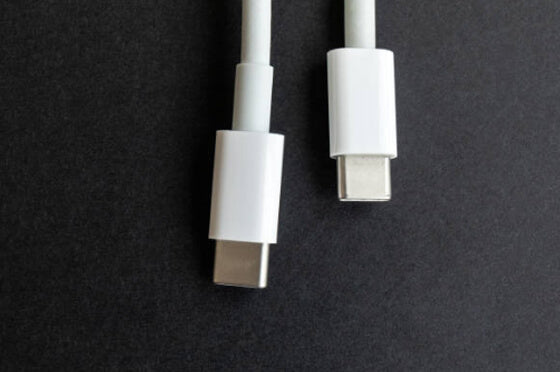Nowadays, not only have many smartphones switched to Type-C interfaces, but computers and USB drives are also popularizing Type-C interfaces. Compared to the situation where various interfaces coexisted in the past, it is really convenient to have a unified interface when our phones or computers are running out of battery.
Why do people favor Type-C interfaces so much? The most common perception of Type-C interfaces is that they don't need to be distinguished between positive and negative, and they charge faster. After all, who can resist the efficiency of "five minutes of charging, two hours of talk time"?
 So, why doesn't Type-C interface need to distinguish between positive and negative? Can it really make charging faster? Let's take a closer look at Type-C.
So, why doesn't Type-C interface need to distinguish between positive and negative? Can it really make charging faster? Let's take a closer look at Type-C.
1. Is Type-C Charging Faster?
Type-C, also known as USB-C, is a standard for electronic device interfaces. In August 2014, the USB Implementers Forum (USBIF) released the USB Type-C interface standard, which has gradually developed into a unified electronic interface due to its technological advantages.
Why is the application of Type-C so widespread? This is mainly because the Type-C interface standard is a crucial component of fast charging technology.

With the development of network technology, smartphones have become increasingly dependent on the internet. As internet speeds increase, smartphones have to handle more tasks simultaneously, resulting in higher power consumption. Currently, there are two ways to reduce smartphone power consumption: upgrading the phone's battery and improving charging technology.
However, there have been few breakthroughs in battery technology, so developing fast charging technology is particularly important to address the issue of fast power consumption in smartphones.
Currently, there are two common types of fast charging technology. One is to increase the charging power by raising the output voltage of the power adapter (commonly known as the charger head), and the other is to increase the charging power by outputting a higher current from the charger head.

In recent years, domestically produced smartphones that utilize low-voltage fast charging technology have rapidly developed and gained market share. Compared to the other charging method, the low-voltage high-current charging method achieves higher efficiency at the same power output. However, traditional cables and interfaces cannot handle high currents, compromising charging safety.
To achieve fast charging while ensuring safety, fast charging charger heads need to convert AC power from our daily lives into the specified voltage and current. At the same time, specialized fast charging cables and interfaces are required for voltage and current transmission.

The Type-C interface has a significantly higher number of contact points compared to traditional interfaces, allowing it to handle much higher currents and making it more suitable for fast charging technology. Additionally, the Type-C interface chip incorporates an E-marker chip that enables mutual recognition, ensuring charging safety and supporting bidirectional charging.
Currently, USB Power Delivery (USBPD) is not standardized and can be compatible with different charging voltages (5V/12V/20V) and charging currents (1.5A/2A/3A/5A). USBPD defines five charging specifications: 10W/18W/36W/60W/100W. Increasing charging power requires higher security standards for interface chips. When combined with USBPD, the Type-C interface can achieve a maximum charging power of 100W, ensuring charging safety under high voltage and high current output.
Therefore, achieving fast charging on a smartphone is not solely dependent on the Type-C interface standard, but it is an important component of fast charging technology. In addition to this, what other advantages does the Type-C interface have?
2. The Advantages of Type-C Interface
-
Not directional
All of the signal pins are designed on the "tongue" in the center, with 12 pins arranged symmetrically, meaning that it no longer needs to be distinguished between the positive and negative.

-
Achieve full functionality as a data cable
It also has the ability to support data, audio, video transmission, and charging functions simultaneously, replacing multiple cables with just one. This means that it can achieve full functionality as a data cable.
-
Powerful data transmission capability
In addition, the Type-C interface has a powerful data transmission capability, supporting bidirectional charging and data transmission. It can also support multiple screen displays and 4K ultra-high resolution transmission. This greatly enhances the convenience of electronic device use as most devices only have one interface.
-
Small in Size
Moreover, the Type-C interface is small in size, making it ideal for use in laptops, where it can save up to 2/3 of the space.
For smartphones, the pursuit of thinner designs has led to the bottleneck of the 3.5mm audio interface, which is no longer able to meet the demand for high-quality digital audio. The Type-C interface is not only smaller than traditional audio interfaces, but it can also achieve digital audio interface, accelerating the phasing out of the 3.5mm traditional audio interface.

-
Extending the lifespan of the interface
Durability is also an important aspect of interface testing, and the Type-C interface directly solves the problem of interface wear caused by users inserting the interface in the wrong direction, extending the lifespan of the interface. Its symmetrical arc appearance and the force applied mainly to the metal casing improve the protection of the data channel in the middle, reducing damage caused by plugging and unplugging the interface.

As an important transmission link for fast charging technology, the Type-C interface not only achieves fast charging but also provides a lot of convenience, such as not having to worry about inserting the interface in the wrong direction or finding various adapter interfaces. Therefore, the rapid popularity of the Type-C interface is reasonable.

